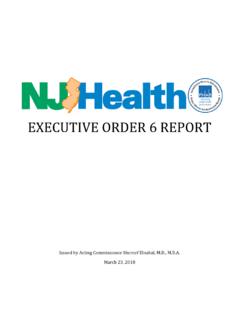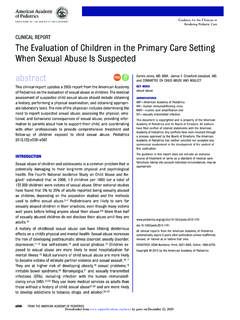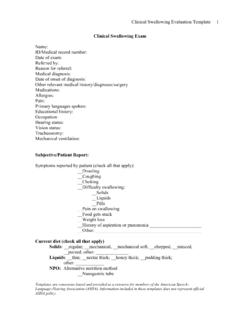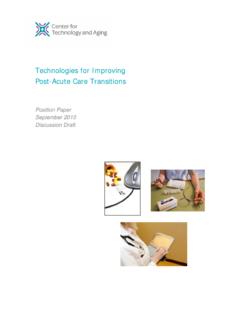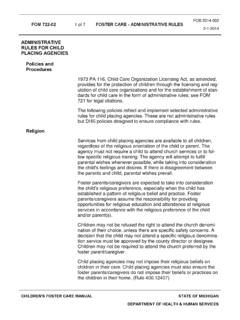Transcription of Updated Guidelines for the Medical Assessment and Care …
1 Mini-Review Updated Guidelines for the Medical Assessment and Care of Children Who May Have Been Sexually Abused Joyce A. Adams MD 1,*, Nancy D. Kellogg MD 2, Karen J. Farst MD 3, Nancy S. Harper MD 4, Vincent J. Palusci MD, MS 5, Lori D. Frasier MD 6, Carolyn J. Levitt MD 7, Robert A. Shapiro MD 8, Rebecca L. Moles MD 9, Suzanne P. Starling MD 10. 1. Department of Pediatrics, University of California, Davis Medical Center, Sacramento, California 2. Department of Pediatrics, University of Texas Health Science Center at San Antonio, San Antonio, Texas 3.
2 Department of Pediatrics, University of Arkansas for Medical Sciences, Arkansas Children's Hospital, Little Rock, Arkansas 4. Department of Pediatrics, University of Minnesota; University of Minnesota Masonic Children's Hospital, Minneapolis, Minnesota 5. Department of Pediatrics, New York University School of Medicine, New York, New York 6. Department of Pediatrics, Penn State Milton S. Hershey Children's Hospital, Hershey, Pennsylvania 7. Department of Pediatrics, University of Minnesota; Children's Hospitals and Clinics of Minnesota, St.
3 Paul, Minnesota 8. Department of Pediatrics, Cincinnati Children's Hospital Medical Center, Cincinnati, Ohio 9. Department of Pediatrics, Yale School of Medicine, New Haven, Connecticut 10. Department of Pediatrics, Eastern Virginia Medical School; Children's Hospital of The King's Daughters, Norfolk, Virginia a b s t r a c t The Medical evaluation is an important part of the clinical and legal process when child sexual abuse is suspected. Practitioners who examine children need to be up to date on current recommendations regarding when, how, and by whom these evaluations should be conducted, as well as how the Medical ndings should be interpreted.
4 A previously published article on Guidelines for Medical care for sexually abused children has been widely used by physicians, nurses, and nurse practitioners to inform practice Guidelines in this eld. Since 2007, when the article was published, new research has suggested changes in some of the Guidelines and in the table that lists Medical and laboratory ndings in children evaluated for suspected sexual abuse and suggests how these ndings should be interpreted with respect to sexual abuse. A group of specialists in child abuse pediatrics met in person and via online communication from 2011 through 2014 to review published research as well as recommendations from the Centers for Disease Control and Prevention and the American Academy of Pe- diatrics and to reach consensus on if and how the Guidelines and approach to interpretation table should be Updated .
5 The revisions are based, when possible, on data from well-designed, unbiased studies published in high-ranking, peer-reviewed, scienti c journals that were reviewed and vetted by the authors. When such studies were not available, recommendations were based on expert consensus. Key Words: Child sexual abuse, Differential diagnosis, Sexually transmitted infections, Expert opinion, Medical history taking, Peer review, Expert testimony Introduction suspected child sexual abuse and the interpretation of Medical ndings.
6 The group reached consensus on the A set of Guidelines and recommendations, published in revision of the 2007 Guidelines , based on literature critique 2007,1 were developed using a process of consensus and review. development after a review of the Medical literature avail- able at the time regarding the Medical evaluation and Medical History interpretation of Medical and laboratory ndings in chil- dren brought for examination for suspected sexual abuse. An accurate and complete history is essential in making This report presents Updated Guidelines , developed after a the Medical diagnosis and determining appropriate treat- review of recently published research and recommenda- ment of child The history includes physical symp- tions from the Centers for Disease Control and Prevention toms, emotional/behavioral symptoms, and information (CDC)2 and the American Academy of Pediatrics (AAP).
7 3 The about the abuse needed to assess and manage suspected authors searched the Medical literature to identify well- victims of abuse. Obtaining details about the abuse is typi- designed, unbiased studies published in high-ranking cally coordinated with a multidisciplinary team and may be journals that addressed the topic of Medical evaluation of obtained by a forensic interviewer or a Medical professional. Due to differences in purpose and approach, the Medical The authors indicate no con icts of interest. The authors received nancial sup- history may differ, yet complement, the forensic interview.
8 Port from the Midwest Regional Children's Advocacy Center, Of ce of Juvenile For example, a Medical history identifying physical symp- Justice and Delinquency Prevention (DOJ) by grant number 2013-CI-FX-K001. toms of painful urination may be directly related to a recent * Address correspondence to: Joyce A. Adams, MD, UC Davis Pediatrics, 2516. Stockton Blvd, 3rd Floor, Sacramento, CA 95817; Phone: 1 (916) 734-3112 episode of sexual abuse and provide additional information E-mail address: ( Adams). of forensic signi 1083-3188/ 2015 North American Society for Pediatric and Adolescent Gynecology.
9 Published by Elsevier Inc. This is an open access article under the CC BY-NC-ND license ( ). 2 Adams et al. / J Pediatr Adolesc Gynecol xxx (2015) 1e7. Table 1. Examination Techniques Genital Examination, Prepubertal Child Anal Examination, Prepubertal Child Examination Positions Supine Frog-leg or Lithotomy Examination Positions Supine Knee-chest Prone Knee-chest (PKC) (In Order of Preference) PKC. Lateral Decubitus Examination technique Labial separation and traction Examination technique Buttock separation PKC with gluteal lift PKC with gluteal lift Speculum examinations not indicated unless child sedated Con rmatory technique Floating hymen with water or saline Con rmatory technique Reassess after bowel movement, PKC with gluteal lift ambulating, or alternate position Genital Examination, Pubertal Child Anal Examination.
10 Pubertal Child Examination positions Supine lithotomy Examination positions Supine knee-chest PKC with gluteal lift PKC. Lateral decubitus Examination technique Labial separation and traction Examination technique Lateral buttock separation Speculum examination can be done if Gluteal lift in PKC. Tanner 3 or greater Con rmatory technique Trace hymenal rim with cotton tip swab Con rmatory technique Reassess after bowel movement, Foley catheter58 ambulating, or alternate position PKC with gluteal lift The process of obtaining the history from the child and the examination, the Medical provider should explain to the nonoffending caregiver also provides an opportunity to caregivers the signi cance of physical ndings, if any.
